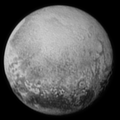File:071215-Pluto-NewHorizons-20150711.png

Original file (682 × 682 pixels, file size: 169 KB, MIME type: image/png)
Captions
Captions
Summary
edit| Description071215-Pluto-NewHorizons-20150711.png |
English: July 12, 2015 - PLUTO - NEW HORIZONS
http://www.nasa.gov/feature/one-million-miles-to-go-pluto-is-more-intriguing-than-ever
http://www.nasa.gov/sites/default/files/thumbnails/image/071215_pluto_alone_0.png Pluto Pluto as seen from New Horizons on July 11, 2015.
http://www.nasa.gov/sites/default/files/thumbnails/image/pluto-annotated.jpg Pluto annotated On July 11, 2015, New Horizons captured a world that is growing more fascinating by the day. For the first time on Pluto, this view reveals linear features that may be cliffs, as well as a circular feature that could be an impact crater. Rotating into view is the bright heart-shaped feature that will be seen in more detail during New Horizons’ closest approach on July 14. The annotated version includes a diagram indicating Pluto’s north pole, equator, and central meridian.
As NASA’s unmanned New Horizons spacecraft speeds closer to a historic July 14 Pluto flyby, it’s continuing to multi-task, producing images of an icy world that’s growing more fascinating and complex every day. On July 11, 2015, New Horizons captured this image, which suggests some new features that are of keen interest to the Geology, Geophysics and Imaging (GGI) team now assembled at the Johns Hopkins University Applied Physics Lab in Laurel, Maryland. For the first time on Pluto, this view reveals linear features that may be cliffs, as well as a circular feature that could be an impact crater. Just starting to rotate into view on the left side of the image is the bright heart-shaped feature that will be seen in more detail during New Horizons’ closest approach. The New Horizons spacecraft is now approaching a milestone – only one million miles to Pluto – which will occur at 11:23 p.m. EDT tonight, Sunday, July 12. It’s approaching Pluto after a more than nine-year, three-billion mile journey. At 7:49 AM EDT on Tuesday, July 14 the unmanned spacecraft will zip past Pluto at 30,800 miles per hour (49,600 kilometers per hour), with a suite of seven science instruments busily gathering data. The mission will complete the initial reconnaissance of the solar system with the first-ever look at the icy dwarf planet. Follow the path of the spacecraft in coming days in real time with a visualization of the actual trajectory data, using NASA’s online Eyes on Pluto. |
| Date | |
| Source | http://www.nasa.gov/sites/default/files/thumbnails/image/071215_pluto_alone_0.png |
| Author | NASA/JHUAPL/SWRI |
Licensing
edit| Public domainPublic domainfalsefalse |
| This file is in the public domain in the United States because it was solely created by NASA. NASA copyright policy states that "NASA material is not protected by copyright unless noted". (See Template:PD-USGov, NASA copyright policy page or JPL Image Use Policy.) |  | |
 |
Warnings:
|
File history
Click on a date/time to view the file as it appeared at that time.
| Date/Time | Thumbnail | Dimensions | User | Comment | |
|---|---|---|---|---|---|
| current | 01:42, 13 July 2015 |  | 682 × 682 (169 KB) | Drbogdan (talk | contribs) | cropped original image file - from 1600x851/406KB to 682x682/168KB - via JASC Paint Shop Pro v6.02 |
| 01:27, 13 July 2015 |  | 1,600 × 851 (407 KB) | Drbogdan (talk | contribs) | User created page with UploadWizard |
You cannot overwrite this file.
File usage on Commons
There are no pages that use this file.
File usage on other wikis
The following other wikis use this file:
- Usage on en.wikipedia.org
- Usage on es.wikipedia.org
- Usage on fa.wikipedia.org
- Usage on hi.wikipedia.org
- Usage on id.wikipedia.org
- Usage on ka.wikipedia.org
- Usage on pnb.wikipedia.org
- Usage on sv.wikipedia.org
- Usage on th.wikipedia.org
- Usage on tr.wikipedia.org
- Usage on ur.wikipedia.org
- Usage on zh.wikipedia.org
Metadata
This file contains additional information such as Exif metadata which may have been added by the digital camera, scanner, or software program used to create or digitize it. If the file has been modified from its original state, some details such as the timestamp may not fully reflect those of the original file. The timestamp is only as accurate as the clock in the camera, and it may be completely wrong.
| File change date and time | 01:36, 13 July 2015 |
|---|---|
| Horizontal resolution | 28 dpc |
| Vertical resolution | 28 dpc |